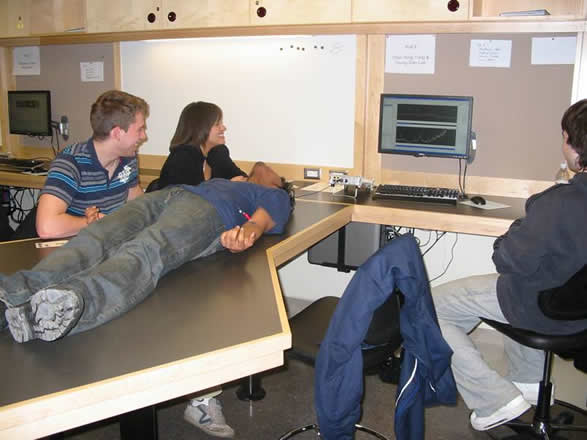I hear ... and I forget I see ... and I remember I do ... and I understand |
||
-- Chinese proverb |
 |
Students in a Practical |
Physics Education Research shows that students learn best:
The Physics Practicals implement the results of this research.
Our course has about 1,000 students. Formerly, students had 2 one-hour classes and 1 one-hour tutorial (aka "recitation session") per week. They also had a three-hour laboratory every second week. The Practicals combine the tutorials and laboratories into a single Physics Practical which meets for two hours every week. We have kept our traditional classes.
There are two types of Practicals:
In addition, we have developed Modules on the Scientific Method, Teamwork, and Formal Reports.
Students work in teams of four. As enrollments shift and some students drop the course, some re-organisation of the teams is necessary. We never have teams with less than three or greater than four students. In addition, half way through each term we shuffle the teams.
Each team has two designated roles:
Every week a different student is chosen by the team for these two roles.
Computers are a vital part of the Practicals. They are used for:
All computers are connected to a Windows server via a private network. The server is where students may save their work. Nothing can be saved on the local PCs, which are frozen using Deep Freeze from Faronics.
We have constructed learning spaces which have an important role in achieving the sort of learning which we believe is most important.
As discussed in the Rooms page, each team of four students work at a Pod. There are nine Pods in each room, and we have two Learning Assistants (formerly Teaching Assistants) present for each session. We attempt to pair experienced and novice Learning Assistants.
 |
Measuring a Student's Electrocardiogram |
At the University of Toronto we have been using active learning models in our Physics courses for some years. These include Peer Instruction, conceptually based Activities such as various Student Workbooks, etc. Design of the Physics Practicals began in 2005. Construction of our first room occured during the Fall of 2007, and the room was used for a Pilot from January - April 2008 and again from September - December 2008. Construction of two more rooms occured during the Fall of 2008, and in January 2009 we did a full "roll out" and dropped our conventional laboratory and tutorials. We anticipate building one or perhaps two more rooms as funding becomes available.
We have prepared two brochures describing the Physics Practicals, which may be accessed via the blue buttons below. They are both in pdf format and will open in a new tab/window.
A two page overview. (4.6 M) |
|
A nine page discussion of the project (6.9 M) |
Last revision of this page: $Date: 2009/03/16 15:57:46 $ (y/m/d UTC).